COLUMN. The pandemic has brought about a major digital transformation in teaching. This has even had an impact on how we run the supplementary program for physicians with a medical degree from outside of the EU. In this column, Henrik Sjövall details his experiences of the measures put in place due to COVID-19.
Regular readers of Akademiliv may recall that I have been working on the supplementary program for physicians with medical degrees from countries outside of the EU for the past 10 years. Over the years, I have shared my experiences of working with this fascinating group of students here (https://akademiliv.se/2013/01/8318/). I have just finished my final course for them, and I will finally be retiring, two years past due. Time passes quickly, and strangely enough I have never worked as much as I have during the past year. During the spring term, I was also engaged in several contentious HTA projects as well as a review of the clinical research system in Sweden for the Swedish Research Council. I also arranged a couple of digital Narrative Rounds: one on “Panic in the time of the Coronavirus” and another on “Long COVID”, the term used for patients that do not fully recover after infection.
From having been program chair to actively teaching and mentoring students
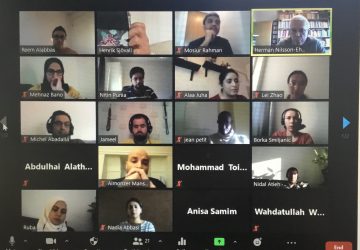
However, the subject of this column is my thoughts on the work my friend, Herman Nilsson-Ehle, and I have done during the past autumn, to keep the supplementary courses in internal medicine and professional development running. I had recently changed roles, from having been program chair to actively teaching and mentoring students. Thus, I have been able to participate in a majority of their classes. This time around the courses were quite different, as we were forced to adjust to the COVID-19 pandemic. Initially, we held a great deal of the courses on campus, but after one COVID-19 case, we decided instead to hold all classes via Zoom.
First a little about the course itself: previously there were two ways to obtain a Swedish medical degree, either to pass the THULE test + approved internship or to take a one-year supplementary program (KUL). The THULE examination has now been replaced with a national competency test at accreditation level. The students we admit to our program have often already taken the test without passing. Now, we have begun to use their test scores as one of the admissions criteria. We had hoped this would allow us to identify students with a fairly good level of competency. The relatively high number of students that fail the internal medicine examination has generally been a problem for us, and we wanted to solve this problem by increasing the number of clinical seminars and by engaging our best teachers. Herman and I were also present at nearly all seminars, which amounted to about a full time job during those months.
Studenternas förmåga att ta upp en fördjupad sjukhistoria varierar rejält
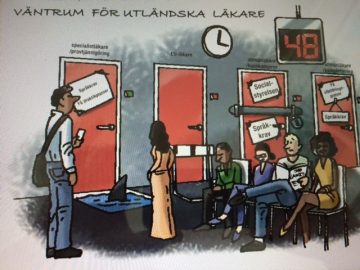
What have we learned from this new approach? Many of the students had substantial difficulties passing the checkpoint tests. They were not comfortable with the in-depth comprehension questions we asked and were more accustomed to reproducing pure factual knowledge in an examination setting. Language difficulties were also common. Some students were unable to understand the questions. Others answered in a way that was impossible to decipher, and subsequently did not understand why they did not receive credit for the exercise. We tried to explain these issues in the one-on-one online feedback sessions and provide them with individualized tips on learning strategies. Sometimes our message was to “read the question properly and limit your response to what has been asked”. In other instances, we told them that they needed to put much more time into studying and preparation. One advantage of the online sessions was that we were unlikely to be interrupted (as long as the internet connection was stable!), which is generally a precondition for giving supportive individual feedback. In some cases, this method proved to be effective. Students that were far from passing at the checkpoints did subsequently pass the exam.
The other half of the online patient consultations involved a mock case or role play. This served as somewhat of a wake-up call, both for us and the students. I selected a case with a half dozen internal medicine diseases that had not been handled well at the primary care level. Among other thing, the patient’s personal and social situation had been misunderstood. A reassessment of the case led to an entirely different treatment strategy. Most of our students had no experience whatsoever of this type of in-depth patient consultation.
Training in critical thinking and reasoning difficult
One lesson we learned from the “online mid-way review” was that most of our students were reasonably successful at learning pure factual information, while many found it more difficult to adopt a systemic approach. We discussed this and concluded that there were probably two causes: the type of instruction they had received in the past and the health care environment they had been trained in. They had often no, or very limited, opportunities for structured follow-up care and they usually worked under tough time constraints, with no resources for clinical reasoning and meaningful differential diagnosis. In most countries there is no functioning system for managing outpatient medical journals. Every patient consultation is a unique entity. As a rule, there are two parallel health care systems, one being private and one public. The two systems generally have entirely different rules and expectations. Patients within the public system do not expect any personal engagement on the part of their doctor. They simply, “want a prescription, otherwise I will go to another doctor!” On the other hand, the private systems are primarily demand-driven, meaning that the patients get what they pay for. In addition, questioning the chief physician’s assessment is unthinkable in many countries’ hierarchical health care systems. This makes training in critical thinking and reasoning difficult.
Because of this, Herman and I decided to place extra focus on critical reasoning, in other words, on assessing the probability of different diagnoses with due consideration to their “urgency or seriousness”. We also decided to clarify how we handle the issue of uncertainty when making a diagnosis. The students were eager to see diagnosis as a dichotomy with a right and a wrong answer (according to the chief physician’s assessment…). They found it difficult to accept that, in our system, many patients only receive a diagnosis based on their symptoms. Most of the students did not seem to have any experience of a functioning, systematic patient follow-up. Therefore, we decided to include more instruction on documentation and patient medical journals.
We were essentially teaching teamwork
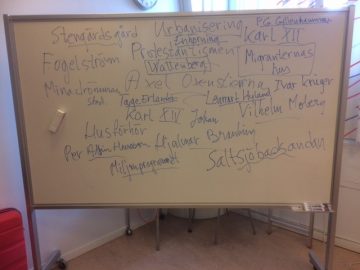
In addition to the courses in internal medicine, Herman and I were responsible for another course module on professional development. This covered the parts of a physician’s job that do not directly concern the study of disease and illness, but rather encompass subjects such as bedside manner, judgement, ethics, and external factors such as time constraints, lack of information, personal shortcomings, and pressure from patients’ relatives and other health professionals. We were essentially teaching teamwork, that is having the wherewithal to ask questions when one is uncertain, showing respect for other professional categories, and creating reasonable frameworks for conveying adverse information. To help our students better understand Swedish society, we also allocated a few hours to a brief review of Sweden’s cultural history. This part of the course was previously highly appreciated.

How did the program turn out this year, during the Coronavirus pandemic? We held the introduction to the PU course before the tightened COVID restrictions were put in place, so we were able to hold that part of the course on campus. We began with exercises in values, in which we presented the students with ethical dilemmas and asked them to “vote” by going to different parts of the room. The “yeses” went to the left, the “maybes” were in the middle, and the “nos” to the right. Sometimes there was a wide difference in opinions, and the ensuing discussion served as a good introduction to the course.
Afterwards we did something exciting. We asked the students to share their own experiences of ethically difficult clinical situations. Their stories were astounding! The first student told the class about an explosion, and that it had only been possible to help a small percentage of the injured patients. The next told us about a dispute concerning a referral that had resulted in a death, for which the student had been blamed, despite not even having been involved in the case. Another had witnessed a patient’s dissatisfied relatives physically assault a doctor. Jenny Milton and I were quiet after hearing their stories. Our ethical dilemmas seemed banal in comparison with their experiences.
Some mock cases, but this time without using actors
How did things work this year, during the Coronavirus pandemic? We chose to maintain the professional development course’s basic structure, including the parts about the organization of health care, teamwork, ethics, conveying adverse information, a bit about Swedish history and culture, and quite a lot about complex health care situations. We did all of this online because of COVID-19. We decided to hold some mock cases, but this time without using actors (https://lakartidningen.se/uncategorized/2019/10/stopp-frys-vad-ar-det-som-hander-hjalp-er-kollega/).

The organization of our society and our health care system may sound like a boring subject, but I tried to spark their interest. First, I presented an empty organizational chart for the Swedish government and public administration. Then, I asked them to fill in the blanks during my lecture. Not exactly easy, is it?
We went on to discuss how a ward, or health care unit, is organized. I started by asking them to name the different professions that work in inpatient care (e.g. different types of doctors, nurses, assistant nurses, etc.). Then we went through the different roles and mandates of these professions systematically. Many of our students found it difficult to grasp nurses’ role as a team leader in health care units. Nurses are only service staff in the health systems they had been accustomed to.
They found it quite difficult to say no
The next day’s theme was ethics, this time primarily based on cases. The first case involved a patient with a stress headache who insisted on a CT scan. They found it quite difficult to say no, due to their backgrounds from demand-driven health care systems. They also had problems understanding our concept of individual autonomy, and they wanted patients’ family and relatives to exercise greater influence over clinical decisions. This was not wholly unexpected, as the majority came from societies in which the family is expected to take care of all life’s trials and tribulations. One case involved the right to question, on ethical grounds, decisions taken by the senior physician on call. This was something that felt extremely foreign to those coming from a strict hierarchical system.
Nurses are subordinate to doctors in their world
Teamwork was the next day’s subject. Nurses are subordinate to doctors in their world, to the extent that even sitting at the same table in the staff room was unthinkable. They were not familiar with the concept of nursing as an independent area of expertise, in which another profession (nurses) has greater competence. We did our best to clarify this and were of the impression that they understood the logic behind our teamwork system. There is also a supplementary program for nurses with foreign qualifications. We discussed whether we should try to plan a meeting with the foreign nurses at some point during the course to discuss these important issues.
As usual, Herman led the discussion on giving adverse information. He has worked with tumor patients, particularly with lymphoma. The main message we tried to relate was that it is extremely important to be consistent. Responsibility lies with the physician to understand the patient’s situation properly and to be willing to listen to the patient’s story. We call this Narrative Medicine.

The students found handling relatives’ opinions problematic; they were used to giving relatives greater influence. We were very clear on the concept of autonomy, but we also tried to shift the focus from inappropriate control to recognizing that friends and relatives may sometimes become an asset to get better contact with the patient. We illustrated this with a patient that had consistently refused a life-saving amputation, but then changed his mind when his good friend Egil, a beekeeper, was called in to persuade him.
To try to understand patients’ needs
We also talked about how much information one should share with patients. We discussed the Health Care Act’s requirements regarding consultation and patients’ rights to access their medical journal. To never lie, but at the same time to avoid being unnecessarily brutal. To try to understand patients’ needs, such as being able to live long enough to celebrate a holiday or see a grandchild born. Narrative Medicine!
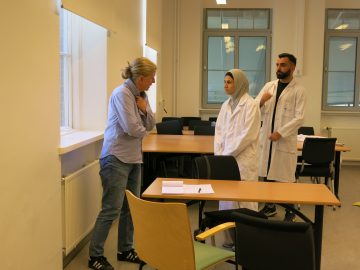
On the last day, we felt we were ready to introduce them to the full complexity of reality. They received two cases. The first case concerned serious psychiatric issues, obscured by an odd personality, with the added touch of a serious physical ailment requiring treatment. The final case was a patient that had been admitted for minor joint problems. However, after an admirably thorough physical examination, another serious illness requiring treatment was identified. Instead of receiving thanks for this finding, the physician was subjected to a barrage of racial slurs. The students were already quite concerned about the risk of being subjected to racism, so this case served to bring the issue out into the open.
Online teaching has, overall, worked surprisingly well, even for subjects concerning patient consultations. By the time this terrible epidemic is over, we will have learned a great deal about the power of online teaching that we can use in the future. The internet cannot replace in-person patient consultations, but it can provide opportunities for individual feedback. It can also be used to simulate difficult clinical situations. The mock cases we had previously done using actors were definitely better. One previous student put it this way, “It was like getting a vaccination against your greatest fears!”
Now it’s time for Herman and me to say farewell. One of the purposes in sharing my reflections here is to find others who might wish to take over this demanding, but stimulating, assignment. Please feel free to contact me if you are interested.
My final message to our students was, “If you want to go fast, go alone; if you want to go far, go together!”
This message still applies in the era of the Coronavirus.
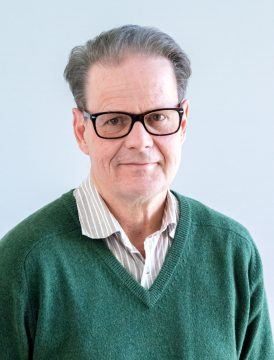
Column by Henrik Sjövall
PS. After reading this, you might be wondering how our students are doing professionally. In general, they are doing very well. Most of them have quickly adopted our way of working. Many of them have landed internships in attractive places and are on their way to becoming specialists in internal medicine, surgeons, primary care physicians, psychiatrists, etc. Several have chosen to relocate and work at smaller hospitals, while others are willing to wait to find an internship locally. After all these years, we have never heard of a case where our KUL students have not managed to function well working in medical care. On the contrary, I often receive positive feedback, such as, “X is highly competent. Didn’t he or she attend your program?!”
Sometimes I see KUL students in town, and they walk up to greet me. They often mention the professional development week as the part of the course that they remember most.
That’s another measure of quality.










